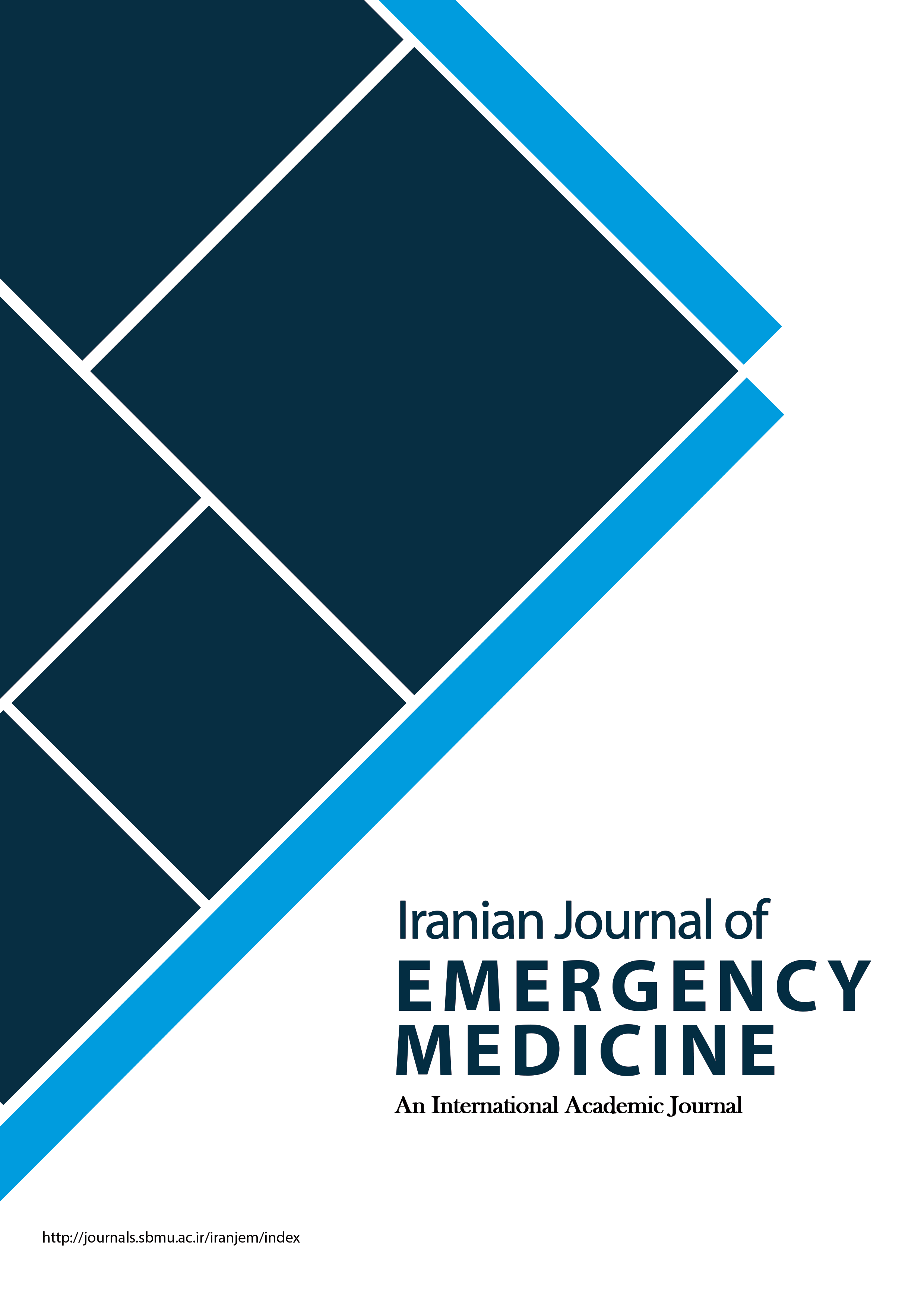Affecting Factors on the Quality of Resident Education in Emergency Department; a Cross-Sectional Study
Iranian Journal of Emergency Medicine,
Vol. 5 No. 1 (2018),
8 February 2018
,
Page e5
https://doi.org/10.22037/ijem.v2i1.18981
Abstract
Introduction: Considering the differences between the infrastructures of healthcare systems in Iran and advanced countries, there is a need for directing the education of emergency medicine residents in a way that not only meets the treatment needs of the society, but can also cover the determined educational goals for the residents of this specialty with the guidance and help of the faculty members. The first steps might be evaluating the present status and surveying the residents and faculty members who are active in emergency medicine specialty. Therefore, the present study was designed and performed with the aim of evaluating the factors affecting the quality of resident education in emergency department (ED). Methods: Initially, a group that consisted of 5 experienced faculty members expressed their opinions on the factors affecting the quality of resident education in an interview, which resulted in the design of a questionnaire with 27 topics that led to preparation of a 23-item questionnaire after validity and reliability evaluation. These items were classified in 3 groups of personal factors, environmental factors, and patient-related factors. Consecutive sampling was done and all the residents and faculty members of emergency medicine in Tehran University of Medical Sciences who were active in this specialty during the study period were eligible to participate in the study. A quantitative survey was done using 5-point Likert scale. Then the data were statistically analyzed to evaluate the agreement rate of the residents and faculty members in each item. Results: In total, 57 residents with the mean age of 32.75 ± 6.12 years and 23 faculty members with the mean age of 39.65 ± 5.54 years participated in the study and filled out the questionnaires. Mean scores of the 3 categories of evaluated factors, namely personal, environmental, and patient-related factors from the viewpoint of all participants were 1.17 ± 0.12, 1.09 ± 0.15, and 1.52 ± 0.22, respectively. The mean scores calculated for the 3 studied categories were not significantly different between the residents and faculty members of emergency medicine who participated in the study (p > 0.05). In the opinion of faculty members, decreasing the number of shifts does not lead to improvement in the quality of resident’s training. However, they believed that 12-hour shifts, clinical rounds in ED and the residents teaching to each other are effective in improvement of the quality of their education and the opinion of residents and faculty members were significantly different in these cases (p < 0.05). Conclusion: Faculty members and residents of emergency medicine do not share the same opinion on working hours, and the number of clinical shifts and their effect on resident training. The faculty members believed that 12-hour shifts provide more opportunities for education compared to 8-hour shifts and reducing the number of clinical shifts would decrease the quality of education.- آموزش؛ طب اورژانس؛ بخش اورژانس؛ آموزش دستیاری
How to Cite
References
Jalili M. Emergency Medicine as an Academic Discipline: Giants strides along an Endless Path. Advanced Journal of Emergency Medicine. 2017;1(1):e1.
Farahmand S. Dr. Shervin Farahmand: Head of Emergency Medicine Department at Tehran University of Medical Sciences. Advanced Journal of Emergency Medicine. 2017;1(1):e11.
Delva MD, Kirby J, Schultz K, Godwin M. Assessing the relationship of learning approaches to workplace climate in clerkship and residency. Academic Medicine. 2004;79(11):1120-6.
Celenza A, Rogers I. Qualitative evaluation of a formal bedside clinical teaching programme in an emergency department. Emergency medicine journal. 2006;23(10):769-73.
Atzema C, Bandiera G, Schull MJ, Coon TP, Milling TJ. Emergency department crowding: the effect on resident education. Annals of emergency medicine. 2005;45(3):276-81.
Bandiera G, Lee S, Tiberius R. Creating effective learning in today's emergency departments: how accomplished teachers get it done. Annals of emergency medicine. 2005;45(3):253-61.
West CP, Shanafelt TD. The influence of personal and environmental factors on professionalism in medical education. BMC medical education. 2007;7(1):29.
Martini S, Arfken CL, Churchill A, Balon R. Burnout comparison among residents in different medical specialties. Academic Psychiatry. 2004;28(3):240-2.
Mann KV, Ruedy J, Millar N, Andreou P. Achievement of non‐cognitive goals of undergraduate medical education: perceptions of medical students, residents, faculty and other health professionals. Medical Education. 2005;39(1):40-8.
Collier VU, McCue JD, Markus A, Smith L. Stress in medical residency: status quo after a decade of reform? Annals of Internal Medicine. 2002;136(5):384-90.
Shanafelt TD, Sloan JA, Habermann TM. The well-being of physicians. The American journal of medicine. 2003;114(6):513-9.
Gabbe SG, Melville J, Mandel L, Walker E. Burnout in chairs of obstetrics and gynecology: Diagnosis, treatment, and prevention: Presidential address. American journal of obstetrics and gynecology. 2002;186(4):601-12.
Jalili M, Sadeghipour Roodsari G, Bassir Nia A. Burnout and Associated Factors among Iranian Emergency Medicine Practitioners. Iranian Journal of Public Health. 2013;42(9):1034-42.
Kamaloo A, Ahmadipour A, Labbaf A, Hesari E, Valadkhani S, Zebardast J, et al. Why Do Emergency Medicine Residents Experience Burn Out? A qualitative study. Iranian Journal of Psychiatry. 2017;12(3):214-8.
Farahmand S, Karimialavijeh E, Vahedi H, Jahanshir A. Emergency medicine as a growing career in Iran: an Internet-based survey. World journal of emergency medicine. 2016;7(3):196-202.
Farahmand S, Aghili SM, Nedjat S, Kia M, Aghili R, Elahi B. Selecting emergency medicine: rationales from perspective of Iranian residents. Acta Medica Iranica. 2014;52(12):922-6.
Baratloo A, Maleki M. Description of a Working Day as a Senior Emergency Medicine Resident; Burning Candle at Both Ends! Emergency. 2015;3(1):1.
Jalili M, Shirani F, Hosseininejad M, Asl-e-Soleimani H. Emergency department nonurgent visits in Iran: prevalence and associated factors. The American journal of managed care. 2013;19(1):e1-8.
Arhami-Dolatabadi A, Maleki M, Memary E, Kariman H, Shojaee M, Baratloo A. The use of emergency department services for non-emergency conditions. Health MED. 2017;11(1):3-9.
Jahanshir A, Bahreini M, Banaie M, Jallili M, Hariri S, Rasooli F, et al. Implementation a Medical Simulation Curriculum in Emergency Medicine Residency Program. Acta Medica Iranica. 2017;55(8):521-4.
- Abstract Viewed: 717 times
- PDF (فارسی) Downloaded: 306 times
- HTML (فارسی) Downloaded: 112 times



